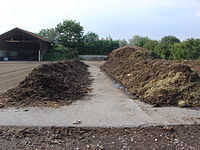
Photo from wikipedia
This study examines the fate of twenty-three representative antibiotic resistance genes (ARGs) encoding tetracyclines, sulfonamides, quinolones, β-lactam antibiotics, macrolides, florfenicol and multidrug resistance during thermophilic aerobic digestion (TAD) of sewage… Click to show full abstract
This study examines the fate of twenty-three representative antibiotic resistance genes (ARGs) encoding tetracyclines, sulfonamides, quinolones, β-lactam antibiotics, macrolides, florfenicol and multidrug resistance during thermophilic aerobic digestion (TAD) of sewage sludge. The bacterial community, class 1 integrons (intI1) and four metal resistance genes (MRGs) were also quantified to determine the key drivers of changes in ARGs during TAD. At the end of digestion, significant decreases in the quantities of ARGs, MRGs and intI1 as well as 16S rRNA genes were observed. Partial redundancy analysis (RDA) showed that shifts in temperature were the key factors affecting a decrease in ARGs. Shifts in temperature led to decreased amounts of ARGs by reducing resistome and bacterial diversity, rather than by lowering horizontal transfer potential via intI1 or co-resistance via MRGs.
Journal Title: Bioresource technology
Year Published: 2018
Link to full text (if available)
Share on Social Media: Sign Up to like & get
recommendations!